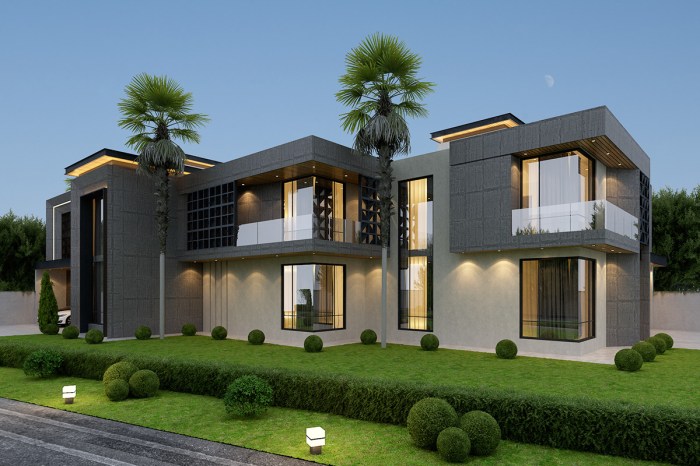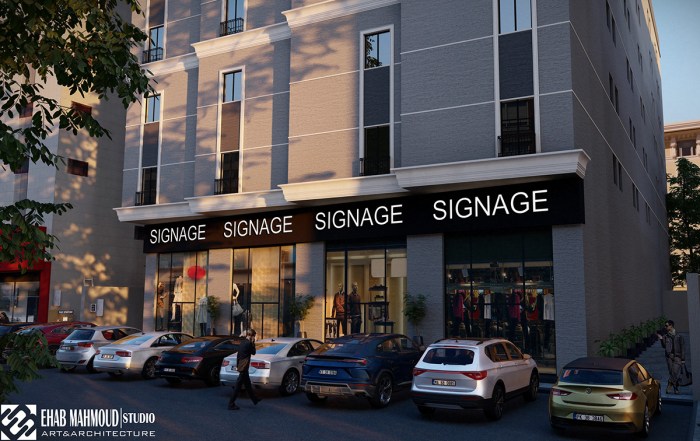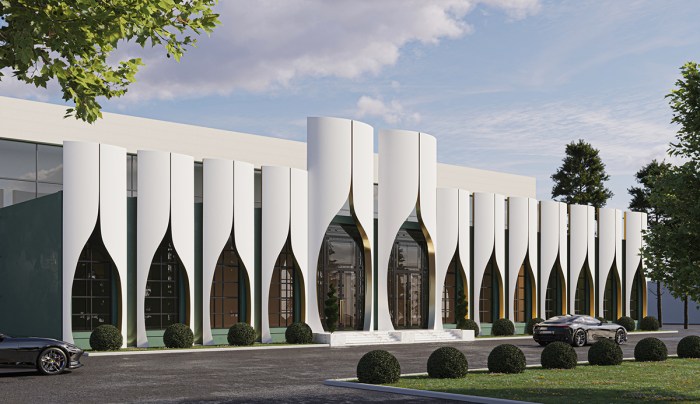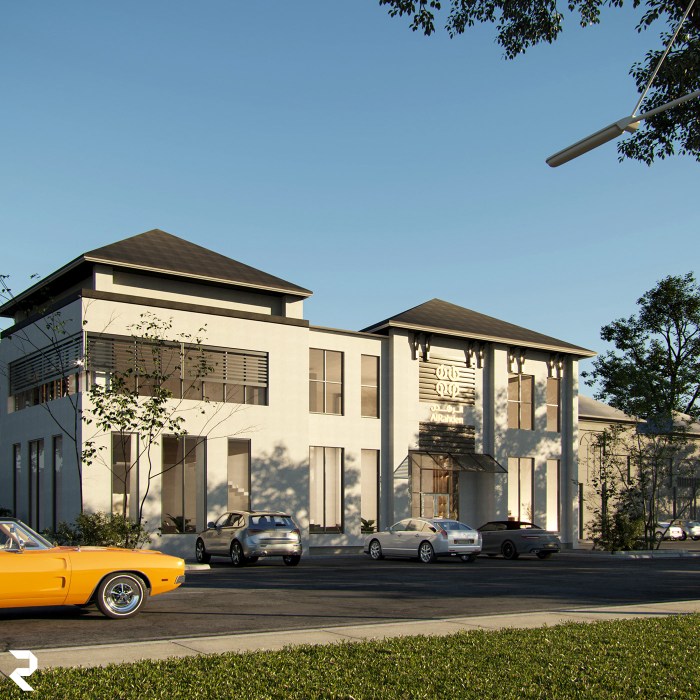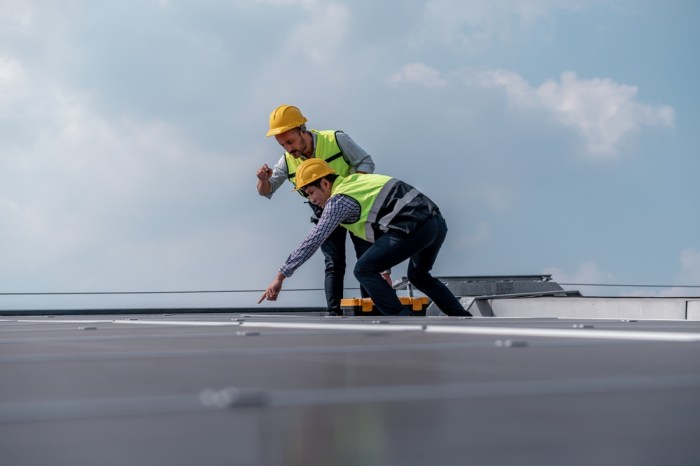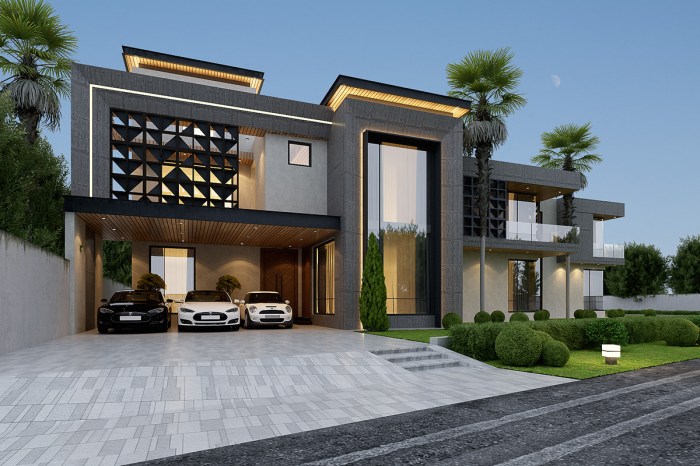Facade Architecture A Timeless Evolution
Facade architecture, a cornerstone of urban design, has evolved dramatically throughout history. From the intricate Romanesque arches to the modern marvels of glass and steel, facades tell stories of their time. This exploration delves into the historical context of facade design, highlighting key periods and styles, and examining how societal and technological advancements have shaped its evolution. We’ll also consider the impact of modern facade designs on urban aesthetics and sustainability.
The historical context of facade architecture reveals fascinating trends, including the shift from traditional materials to innovative ones. The evolution of techniques and styles is also a major theme. Modern designs are discussed in terms of sustainability, innovative materials, and how these affect urban landscapes. Finally, the crucial relationship between facade architecture and urban design, including how facades enhance public spaces and address urban challenges, will be examined.
Historical Context of Facade Architecture
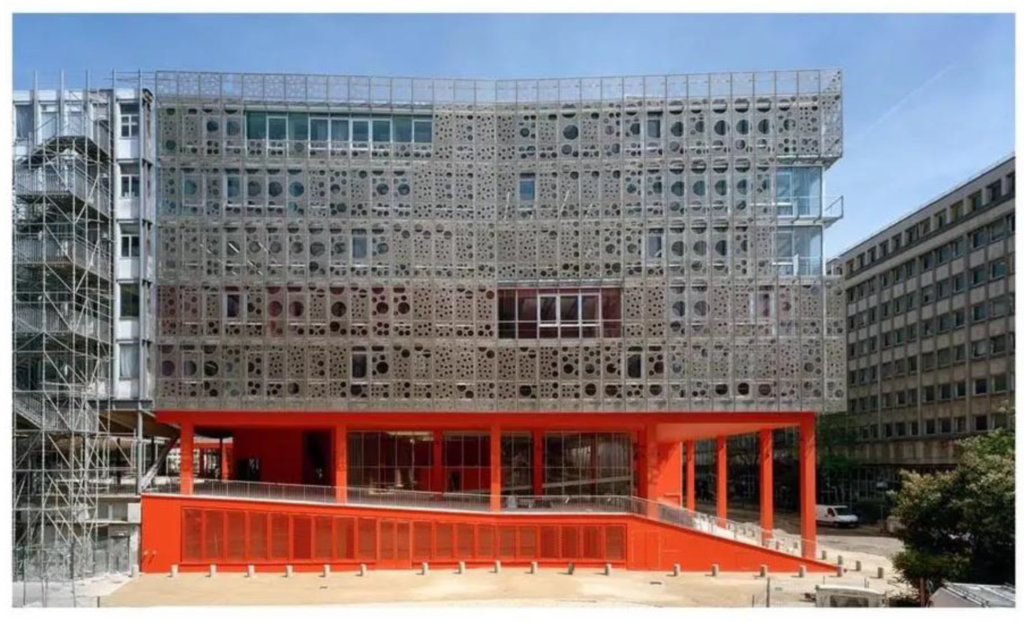
Facade architecture, the design and construction of building exteriors, has undergone a fascinating evolution throughout history. Driven by societal needs, technological advancements, and aesthetic sensibilities, facades have reflected the values and capabilities of their time. From the sturdy Romanesque to the ornate Baroque, each period has left an indelible mark on the way we perceive and interact with the built environment.
The study of facade architecture offers valuable insights into the development of civilizations. By examining the materials, techniques, and styles employed in different eras, we can understand how societies have adapted and innovated in response to both practical and artistic demands. This historical overview will explore the key periods and styles, tracing the evolution of materials and construction, and highlighting the impact of societal and technological progress on facade design.
Chronological Overview of Facade Design Trends
Facade design has evolved significantly over time, reflecting shifts in social values, technological advancements, and aesthetic preferences. This evolution can be categorized into distinct historical periods, each with its unique characteristics.
| Period | Style | Materials | Key Features |
|---|---|---|---|
| Romanesque (c. 1000-1200) | Robust, monumental | Stone, brick, timber | Thick walls, rounded arches, massive proportions, emphasis on structural integrity, simple decorative elements. |
| Gothic (c. 1200-1500) | Pointed arches, ribbed vaults | Stone, stained glass, timber | Soaring heights, pointed arches, ribbed vaults, stained glass windows, intricate stone carvings, emphasis on verticality and light. The Cathedral of Notre Dame is a prime example. |
| Renaissance (c. 1400-1600) | Classical revival | Stone, marble, stucco | Symmetrical facades, classical orders (Doric, Ionic, Corinthian), pilasters, pediments, emphasis on harmony and balance. The Palazzo Pitti in Florence exemplifies this style. |
| Baroque (c. 1600-1750) | Ornate, dynamic | Stone, stucco, decorative elements | Elaborate ornamentation, dramatic use of curves and volumes, asymmetrical compositions, emphasis on emotional impact. The Palace of Versailles showcases this style. |
| Neoclassical (c. 1750-1850) | Classical revival | Stone, marble, stucco, decorative elements | Symmetrical facades, classical orders, emphasis on order and reason, simpler ornamentation compared to Baroque. The US Capitol Building is a notable example. |
Evolution of Materials and Construction Techniques
The availability and use of building materials have significantly influenced facade design throughout history. Early periods relied on readily available materials like stone and timber. The development of techniques like bricklaying and concrete allowed for more complex designs and structures. The introduction of new materials, such as steel and glass, revolutionized facade architecture in later periods.
- Romanesque builders utilized locally sourced stone and brick for durability and cost-effectiveness, creating massive, sturdy walls. Gothic builders, however, employed advanced techniques to achieve incredible heights and intricate designs with the same materials. The use of pointed arches and ribbed vaults enabled the creation of vast interior spaces, and the addition of stained glass provided an unparalleled level of light and color.
- The Renaissance saw a resurgence of classical orders and a focus on the use of marble and stucco for a refined aesthetic. Baroque architecture often employed plaster and decorative elements to create elaborate and dynamic facades. Neoclassical architecture continued this trend with a preference for classical orders and symmetrical designs.
- The Industrial Revolution brought significant changes to building materials. The availability of steel allowed for more complex structural solutions, and glass became a prominent material for creating transparent and airy facades. These innovations allowed for unprecedented heights and forms.
Influence of Societal and Technological Advancements
Societal and technological advancements have profoundly shaped facade architecture. The growth of cities, shifts in religious beliefs, and technological innovations in construction all contributed to the evolution of facades. Each period reflects the priorities and capabilities of the time.
- Religious and political power influenced the design of facades. Cathedrals, for instance, showcased the wealth and faith of a community. Similarly, palaces and government buildings often reflected the power and prestige of ruling elites.
- Technological advancements enabled the creation of more complex and ambitious structures. The use of advanced materials and techniques allowed for innovative designs, leading to the development of distinctive architectural styles.
- Economic factors also played a role. The availability and cost of materials directly impacted the design and decoration of facades. The shift from local materials to imported ones reflects the evolving trade routes and economic systems.
Modern Facade Designs and Innovations
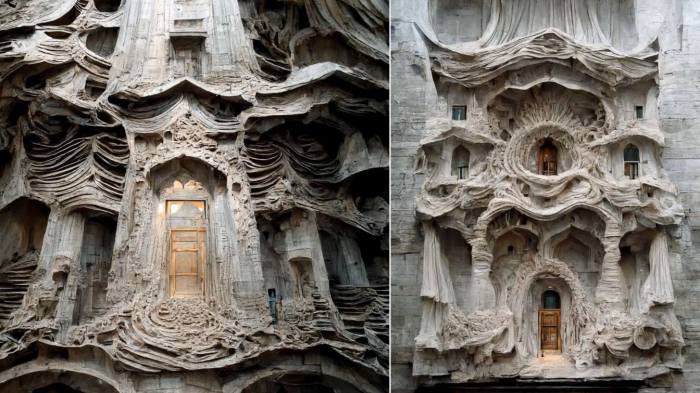
Source: amazingarchitecture.com
Modern facade designs are constantly evolving, driven by advancements in materials, technology, and a growing emphasis on sustainability. These innovations not only enhance the aesthetic appeal of buildings but also contribute to their energy efficiency and environmental responsibility. The integration of sustainable materials and intelligent systems are shaping the future of building exteriors.
Contemporary facade design trends showcase a departure from traditional approaches, embracing novel techniques and a focus on functionality alongside aesthetics. These modern approaches utilize innovative technologies, allowing architects to create dynamic and responsive building exteriors.
Contemporary Facade Design Trends
Modern facade designs are characterized by a variety of innovative approaches. A key trend involves the incorporation of sustainable materials and technologies, leading to significant improvements in energy efficiency and environmental impact. This includes using recycled materials, locally sourced components, and materials with low embodied energy.
Sustainable Materials and Technologies
The increasing emphasis on sustainability has led to a rise in the use of environmentally friendly materials in facade construction. These materials often exhibit superior thermal performance, reduced embodied carbon, and recyclability. Examples include reclaimed wood, bamboo, and various types of recycled glass and concrete. Advanced insulation materials and high-performance glazing systems are frequently employed to minimize energy consumption.
Innovative Approaches to Facade Design
Innovative approaches to facade design are transforming building exteriors. Dynamic facades, for example, use motorized elements or programmable systems to adjust the building’s appearance based on environmental conditions. These dynamic facades can optimize natural light and ventilation, improving occupant comfort and energy efficiency. Integrated systems, which combine facade components with building management systems, are becoming increasingly prevalent. These systems allow for real-time monitoring and control of facade performance, enabling more efficient use of energy and resources.
Role of Sustainability and Energy Efficiency
Sustainability and energy efficiency play a pivotal role in modern facade architecture. Modern facades are designed to minimize energy consumption, reducing the building’s carbon footprint. The incorporation of passive design strategies, such as optimizing natural light and ventilation, and the use of high-performance glazing systems are crucial elements in achieving this. A strong emphasis on material selection, with a focus on low embodied energy and recyclability, is also vital.
Comparison of Facade Materials
Different facade materials offer unique properties and advantages. Glass, for instance, allows natural light penetration, offering aesthetic appeal, but its thermal performance can vary significantly depending on the type of glass and its coatings. Metal facades, like aluminum or stainless steel, provide a sleek aesthetic and excellent durability, but can require specialized maintenance. Concrete facades, while robust and cost-effective, can be heavy and require careful consideration of thermal properties.
Modern Facade Designs Table
| Design Type | Examples | Materials | Environmental Impact |
|---|---|---|---|
| Dynamic Facade | Curtain walls with adjustable fins | Aluminum, glass, steel | Reduced energy consumption, improved natural light |
| Integrated System | Building facades with integrated solar panels | Glass, metal, photovoltaic cells | Reduced reliance on grid power, energy generation |
| Sustainable Facade | Buildings utilizing bamboo and reclaimed wood | Bamboo, reclaimed wood, recycled glass | Reduced embodied carbon, enhanced sustainability |
| High-Performance Glazing | Buildings using low-E glass | Low-E glass, coated glass | Improved thermal performance, reduced energy loss |
Facade Architecture and Urban Design
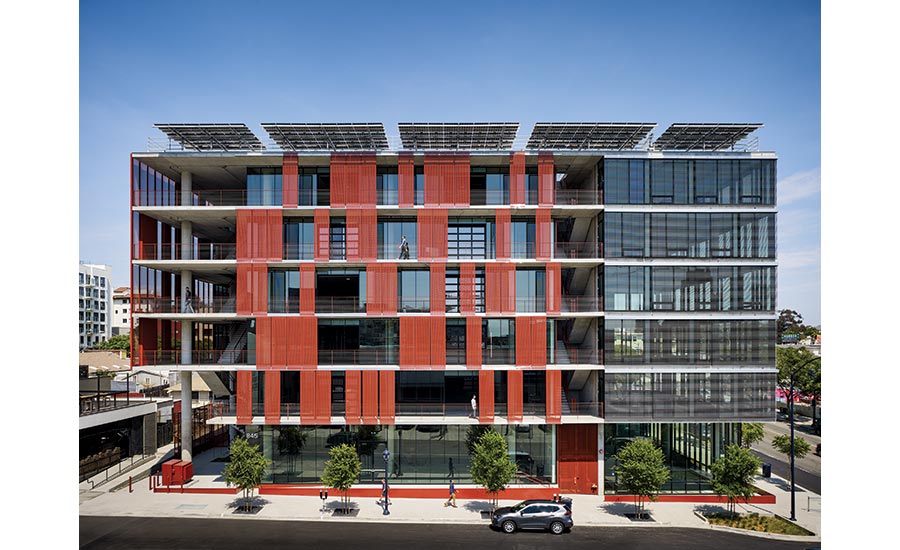
Facade architecture plays a pivotal role in shaping the urban landscape, influencing aesthetics, community interaction, and the overall urban experience. Beyond mere aesthetics, well-designed facades can address crucial urban challenges, contributing to a more livable and sustainable environment. The integration of design principles with practical considerations is key to creating vibrant and resilient urban spaces.
Effective facade designs are intrinsically linked to the character and identity of a city or neighborhood. They act as a visual narrative, reflecting historical contexts, cultural influences, and contemporary design sensibilities. Careful consideration of materials, colors, textures, and spatial arrangements contributes to the unique identity of a place.
Impact on Urban Aesthetics and Experience
Facade designs profoundly impact the visual appeal and overall experience of urban spaces. Attractive facades can enhance the city’s visual appeal, making it more inviting and stimulating for residents and visitors. Conversely, poorly designed facades can detract from the aesthetic quality of the urban environment. Consider a city with a mix of historical buildings and modern structures; harmonious integration of styles can create a captivating urban landscape, while a jarring contrast can diminish the overall aesthetic. The use of vibrant colors, interesting textures, and innovative materials can significantly contribute to the visual appeal of a city.
Contribution to City and Neighborhood Character
Facade designs significantly contribute to the distinct character and identity of a city or neighborhood. A series of similar facades, perhaps with uniform materials and styles, can create a cohesive and recognizable neighborhood. Alternatively, varied and eclectic facades can reflect a vibrant and diverse urban environment. The historic character of a city can be preserved through the careful restoration and design of facades that reflect the building’s historical significance.
Enhancement of Public Spaces and Community Interaction
Well-designed facades can actively contribute to public spaces and community interaction. Open balconies, communal gardens integrated into facades, and strategically placed windows can foster social interaction and create a sense of community. Transparent facades can encourage transparency and visual connection between different parts of a building and the surrounding neighborhood, fostering interaction.
Addressing Urban Challenges
Facade architecture can effectively address critical urban challenges. Facades can be designed to minimize light pollution by using reflective materials or strategically placed vegetation. Sound-absorbing materials and acoustic designs can mitigate noise pollution, creating quieter and more peaceful urban environments. Accessibility features, such as ramps, wider doorways, and tactile paving integrated into facades, can enhance accessibility for all residents.
Relationship between Facade Architecture, Urban Context, and Societal Impact
| Facade Architecture Feature | Urban Context | Societal Impact |
|---|---|---|
| Historical preservation of facades | Preservation of heritage, reflecting history and culture | Enhanced cultural identity, increased tourism, pride in community |
| Modern, innovative facades | Reflecting contemporary trends and technological advancements | Improved aesthetics, increased economic activity, enhanced public image |
| Facades integrating green elements | Improved air quality, reduced urban heat island effect | Improved health, increased well-being, enhanced biodiversity |
| Facades with accessible design elements | Inclusivity, accommodating diverse needs | Increased social equity, enhanced quality of life for all citizens |
| Facades mitigating light and noise pollution | Improved quality of life, creating a more sustainable environment | Reduced health issues, enhanced mental well-being, improved sleep patterns |
Last Recap
In conclusion, facade architecture transcends mere aesthetics. It reflects historical periods, societal values, and technological advancements. The evolution from historical styles to modern innovations demonstrates the enduring influence of facade design on urban environments. From ancient Roman structures to contemporary sustainable designs, facades offer a powerful lens through which to understand cultural shifts and the ongoing quest for creating beautiful and functional urban spaces. The discussion has highlighted the critical role of facades in shaping our cities, impacting urban aesthetics, and addressing societal needs. This exploration provides a comprehensive understanding of the field.
